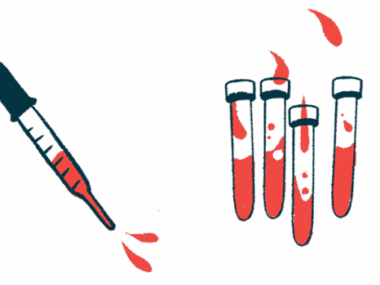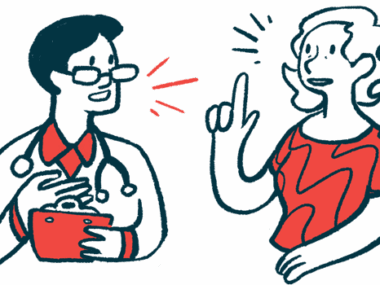Almost all kids given early Evrysdi walking 3 years later: Trial data
No need for respiratory support for most children on approved SMA therapy
Written by |

Nearly all children with spinal muscular atrophy (SMA) who were started early on Evrysdi (risdiplam) in a clinical trial — as newborns, before the onset of symptoms — are now walking after three years on the approved oral therapy.
Further, most of the youngsters also have no need for nutritional or respiratory support.
That’s according to new data shared at the 30th Congress of the World Muscle Society, held last week in Vienna. The presentation, given by Maria Mazurkiewicz-Bełdzińska, MD, PhD, chair of neurology at the Medical University of Gdańsk in Poland, was titled “RAINBOWFISH: 3-year efficacy and safety data of risdiplam in infants with presymptomatic spinal muscular atrophy (SMA).” The work was funded by Roche, which markets Evrysdi through its subsidiary Genentech.
“The majority of children achieved sitting, standing and walking milestones and maintained the abilities up to year [three],” the scientists noted in the presentation, provided by Genetech in an email to SMA News Today. The presentation slides noted that “none [of the children] required respiratory support outside of an illness.”
A genetic disorder, SMA is mainly caused by mutations in the SMN1 gene, which lead to low levels of SMN, a protein vital for the survival of motor neurons — the nerve cells that control movement. Lack of SMN leads motor neurons to sicken and die, resulting in muscle weakness, a hallmark symptom of SMA.
Evrysdi, a therapy given orally, is designed to boost SMN protein levels by modulating the activity of a related gene called SMN2. By increasing SMN protein levels, it aims to preserve nerve cell health and slow disease progression.
Children given treatment as newborns in RAINBOWFISH trial
In the Phase 2 RAINBOWFISH trial (NCT03779334), Evrysdi treatment was given to infants ages 6 weeks or younger who had been diagnosed with SMA by genetic screening but did not yet have any overt symptoms of the disease.
Most of the 26 children in the study had three or more copies of the SMN2 gene; eight of the participants had two copies of this gene. Generally, SMA patients with fewer copies of this gene have more severe disease.
Findings from the first two years of the study were published this summer in The New England Journal of Medicine, in a paper titled “Risdiplam in Presymptomatic Spinal Muscular Atrophy.”
The results showed that, after one year on Evrysdi, 25 of the children were able to sit independently; the outlier was a child with two SMN2 gene copies. Over the first two years of follow-up, six of the eight patients with two SMN2 gene copies developed symptoms indicative of SMA. Three, including the one who wasn’t able to sit up without help, withdrew from the study to switch to Zolgensma (onasemnogene abeparvovec-xioi), a one-time gene therapy for certain SMA patients.
Among the 23 children who remained in the study, almost all were able to walk at two years. The exceptions were two children with two SMN2 copies; both of these youngsters could sit unsupported but could not stand or walk.
Nearly all children on Evrysdi fed ‘exclusively orally’
The new data show that all 21 patients who could walk after two years are still able to walk at three years. The two children who couldn’t walk at year two still can’t, but they can still sit unsupported — in other words, while on long-term Evrysdi, none of the children lost any of the abilities they had gained in early development.
This markedly contrasts with the typical course of SMA, in which children often don’t reach major motor milestones, and those who do usually go on to lose their abilities as the disease progresses.
Further, while children with untreated SMA often need respiratory and nutritional support — often ventilators and feeding tubes — most of the children in this study have had no need for this type of medical intervention. All of the children are able to swallow, according to the new data.
The data show that one of the children is only able to eat soft or pureed food and receives a small amount of nutrition through tube feeding. Additionally, one needed cough assist during a respiratory illness. However, those have been the only exceptions so far, according to the researchers.
A chart on one of the presentation slides noted that “96% (22/23) of children were fed exclusively orally.”
The majority of children treated with [Evrysdi] before the onset of SMA symptoms, maintained motor milestones and bulbar [mouth-and-throat] function and showed cognitive skills similar to children without SMA.
The data also show that, on cognitive assessments, these youngsters are scoring within normal ranges for children in the general population. Speech development has been normal in all participants.
Additionally, long-term safety data showed no serious side effects related to the therapy. The researchers highlighted that more than 80% of the children have not needed to be hospitalized so far.
On the concluding slide, the researchers wrote that “the majority of children treated with [Evrysdi] before the onset of SMA symptoms, maintained motor milestones and bulbar [mouth-and-throat] function and showed cognitive skills similar to children without SMA.”








